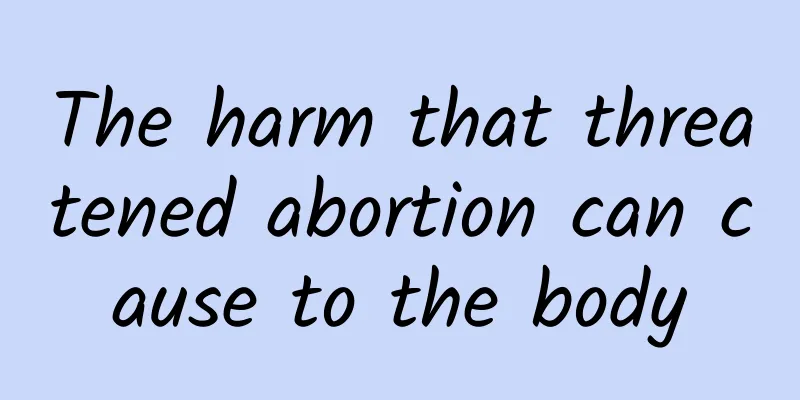Prevention of cervical precancerous lesions

|
Should we prevent and treat cervical precancerous lesions? Gynecological experts believe that we should start from two aspects to prevent cervical precancerous lesions. One is the prevention of the cause, and the other is preclinical prevention, namely the "three early" prevention. 1. Prevention of causes Although the cause of cervical precancerous lesions is not completely clear, it is known that cervical precancerous lesions are infectious diseases related to HPV (human papillomavirus), which can be controlled by targeting these factors, such as advocating late marriage, prohibiting early marriage and sexual disorder, implementing family planning, strengthening sexual morality and sexual health education, and actively preventing and treating diseases related to cervical precancerous lesions. In addition, we should strengthen environmental protection, proper diet, and proper exercise to improve physical and mental health and immunity. 2. Preclinical prevention is the “three early” prevention The so-called "three earlys" refer to early detection, early diagnosis, and early treatment. Their purpose is to prevent the development of the initial disease. Early signs of cervical precancerous lesions include: (1) increased leucorrhea, which may have no abnormal odor in the early stages; (2) abnormal leucorrhea, which may be mixed with blood and accompanied by a foul smell; (3) irregular vaginal bleeding, which is often seen during sexual intercourse, bleeding after exertion in the lower abdomen, and bleeding after menopause; (4) after the development of cervical precancerous lesions, urinary irritation, frequent urination, and blood in the stool may occur, and it may also cause pelvic and lower limb pain and lower limb swelling. The following groups should have a gynecological cancer prevention examination every 2-3 years: those who have sexual intercourse or marriage before the age of 18; those with disordered sexual life, frequent sexual intercourse, and sexually transmitted diseases; those who marry early and have multiple births; those with cervical inflammation and erosion; those with vaginal bleeding after sexual intercourse, vaginal discharge after menopause, especially bloody discharge; those over 35 years old without any symptoms should also have regular routine examinations. LCT, colposcopy, and cervical biopsy can be performed when necessary. Treatment of precancerous lesions: If cervical erosion, CIN and other precancerous lesions are found, they should be treated in time. There are many treatment methods for cervical precancerous lesions, such as cervical electrocautery, electric baking, freezing, laser treatment, etc. The most commonly used methods are LEEP knife electroresection and cervical cold knife cone biopsy. The key is to choose the appropriate treatment method according to the condition. |
<<: Early prevention of cervical precancerous lesions
>>: The key to preventing cervical precancerous lesions
Recommend
How long will acute vaginitis take to heal?
How long will acute vaginitis take to heal? 1. Ac...
How long can you live after treatment of late-stage Bartholinitis?
In today's society, people live at a fast pac...
What are the early symptoms of ectopic pregnancy?
What are the early symptoms of ectopic pregnancy?...
Being called fat makes you fatter! The probability increased by 2.5 times
People who are often teased as "fat" by...
How to use medicine for endometrial tuberculosis
When endometrial tuberculosis occurs, it will ser...
The nemesis of apple-shaped and pear-shaped obesity! Chinese medicine doctor Liao Qianhui: 2 drinks to quickly slim down your belly and buttocks
Spring is the time for girls to show off their sl...
What are the hazards of pregnancy complicated with uterine fibroids?
The incidence of gynecological diseases is very h...
What medicine should I take to treat uterine fibroids during menstruation? What should I eat to detoxify during menstruation if I have uterine fibroids?
Uterine fibroids during menstruation are one of t...
What causes habitual miscarriage? Pay attention to these 3 reasons
There are many reasons for habitual miscarriage. ...
How long after a miscarriage can I wash my hair? What should I eat to recover quickly after a miscarriage?
Miscarriage is a very helpless thing for women, b...
There is no quick way to lose weight after the Chinese New Year. Eat less and exercise more. 4 tips
You gain weight after the Chinese New Year. If yo...
Can women drink coffee during menstruation? 6 foods you should avoid
During menstruation, women should not eat spicy f...
Sweet potato leaves are very effective in protecting the liver and detoxifying. Which is healthier, boiled or fried?
People often suffer from insomnia due to stress, ...
What causes irregular menstruation in women?
There are many types of irregular menstruation in...
How much does it cost to treat uterine fibroids?
How much does it cost to treat uterine fibroids? ...









